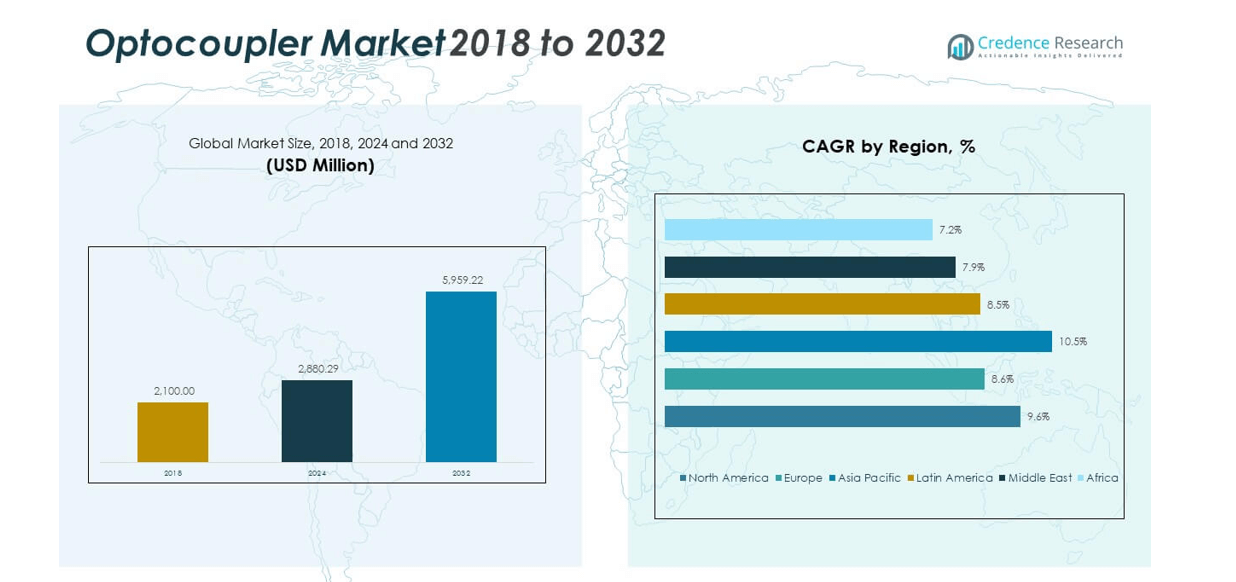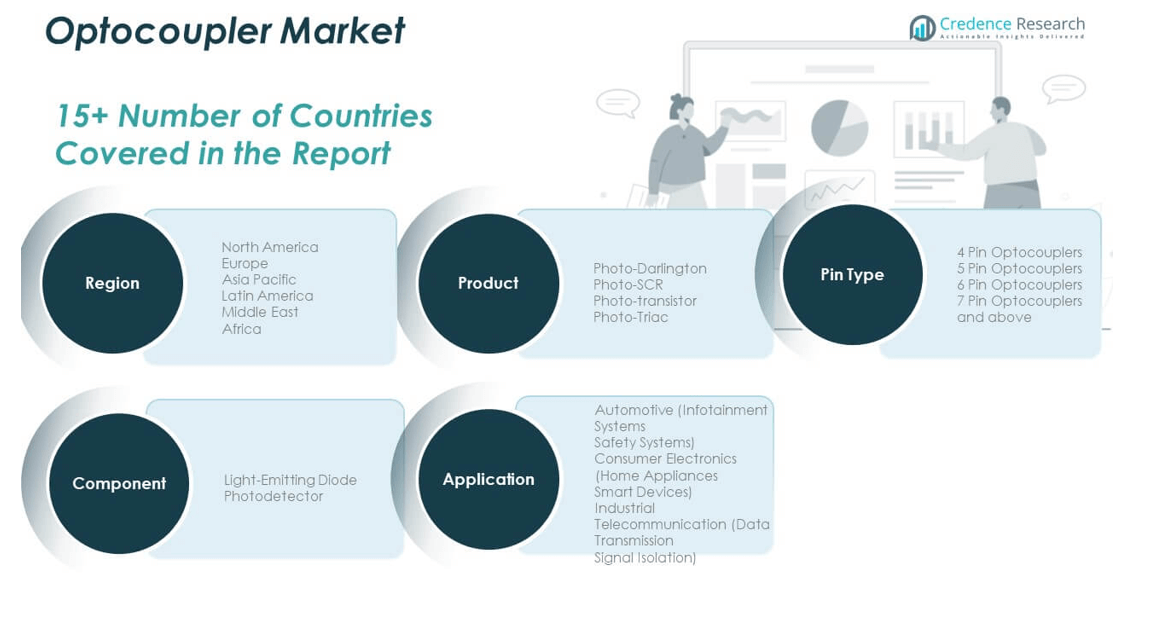CHAPTER NO. 1 : GENESIS OF THE MARKET
1.1 Market Prelude – Introduction & Scope
1.2 The Big Picture – Objectives & Vision
1.3 Strategic Edge – Unique Value Proposition
1.4 Stakeholder Compass – Key Beneficiaries
CHAPTER NO. 2 : EXECUTIVE LENS
2.1 Pulse of the Industry – Market Snapshot
2.2 Growth Arc – Revenue Projections (USD Million)
2.3. Premium Insights – Based on Primary Interviews
CHAPTER NO. 3 : OPTOCOUPLER MARKET FORCES & INDUSTRY PULSE
3.1 Foundations of Change – Market Overview
3.2 Catalysts of Expansion – Key Market Drivers
3.2.1 Momentum Boosters – Growth Triggers
3.2.2 Innovation Fuel – Disruptive Technologies
3.3 Headwinds & Crosswinds – Market Restraints
3.3.1 Regulatory Tides – Compliance Challenges
3.3.2 Economic Frictions – Inflationary Pressures
3.4 Untapped Horizons – Growth Potential & Opportunities
3.5 Strategic Navigation – Industry Frameworks
3.5.1 Market Equilibrium – Porter’s Five Forces
3.5.2 Ecosystem Dynamics – Value Chain Analysis
3.5.3 Macro Forces – PESTEL Breakdown
3.6 Price Trend Analysis
3.6.1 Regional Price Trend
3.6.2 Price Trend by product
CHAPTER NO. 4 : KEY INVESTMENT EPICENTER
4.1 Regional Goldmines – High-Growth Geographies
4.2 Product Frontiers – Lucrative Product Categories
4.3 Pin Type Sweet Spots – Emerging Demand Segments
CHAPTER NO. 5: REVENUE TRAJECTORY & WEALTH MAPPING
5.1 Momentum Metrics – Forecast & Growth Curves
5.2 Regional Revenue Footprint – Market Share Insights
5.3 Segmental Wealth Flow – Product & Pin Type Revenue
CHAPTER NO. 6 : TRADE & COMMERCE ANALYSIS
6.1. Import Analysis by Region
6.1.1. Global Optocoupler Market Import Revenue By Region
6.2. Export Analysis by Region
6.2.1. Global Optocoupler Market Export Revenue By Region
CHAPTER NO. 7 : COMPETITION ANALYSIS
7.1. Company Market Share Analysis
7.1.1. Global Optocoupler Market: Company Market Share
7.2. Global Optocoupler Market Company Revenue Market Share
7.3. Strategic Developments
7.3.1. Acquisitions & Mergers
7.3.2. New Product Launch
7.3.3. Regional Expansion
7.4. Competitive Dashboard
7.5. Company Assessment Metrics, 2024
CHAPTER NO. 8 : OPTOCOUPLER MARKET – BY PRODUCT SEGMENT ANALYSIS
8.1. Optocoupler Market Overview by Product Segment
8.1.1. Optocoupler Market Revenue Share By Product
8.2. Photo-Darlington
8.3. Photo-SCR
8.4. Photo-transistor
8.5. Photo-Triac
CHAPTER NO. 9 : OPTOCOUPLER MARKET – BY PIN TYPE SEGMENT ANALYSIS
9.1. Optocoupler Market Overview by Pin Type Segment
9.1.1. Optocoupler Market Revenue Share By Pin Type
9.2. 4 Pin Optocouplers
9.3. 5 Pin Optocouplers
9.4. 6 Pin Optocouplers
9.5. 7 Pin Optocouplers and above
CHAPTER NO. 10 : OPTOCOUPLER MARKET – BY COMPONENT SEGMENT ANALYSIS
10.1. Optocoupler Market Overview by Component Segment
10.1.1. Optocoupler Market Revenue Share By Component
10.2. Light-Emitting Diode
10.3. Photodetector
CHAPTER NO. 11 : OPTOCOUPLER MARKET – BY APPLICATION SEGMENT ANALYSIS
11.1. Optocoupler Market Overview by Application Segment
11.1.1. Optocoupler Market Revenue Share By Application
11.2. Automotive (Infotainment Systems Safety Systems)
11.3. Consumer Electronics (Home Appliances Smart Devices)
11.4. Industrial
11.5. Telecommunication (Data Transmission Signal Isolation)
CHAPTER NO. 12 : OPTOCOUPLER MARKET – REGIONAL ANALYSIS
12.1. Optocoupler Market Overview by Region Segment
12.1.1. Global Optocoupler Market Revenue Share By Region
12.1.2. Regions
12.1.3. Global Optocoupler Market Revenue By Region
12.1.4. Product
12.1.5. Global Optocoupler Market Revenue By Product
12.1.6. Pin Type
12.1.7. Global Optocoupler Market Revenue By Pin Type
12.1.8. Component
12.1.9. Global Optocoupler Market Revenue By Component
12.1.10. Application
12.1.11. Global Optocoupler Market Revenue By Application
CHAPTER NO. 13 : NORTH AMERICA OPTOCOUPLER MARKET – COUNTRY ANALYSIS
13.1. North America Optocoupler Market Overview by Country Segment
13.1.1. North America Optocoupler Market Revenue Share By Region
13.2. North America
13.2.1. North America Optocoupler Market Revenue By Country
13.2.2. Product
13.2.3. North America Optocoupler Market Revenue By Product
13.2.4. Pin Type
13.2.5. North America Optocoupler Market Revenue By Pin Type
13.2.6. Component
13.2.7. North America Optocoupler Market Revenue By Component
13.2.8. Application
13.2.9. North America Optocoupler Market Revenue By Application
13.3. U.S.
13.4. Canada
13.5. Mexico
CHAPTER NO. 14 : EUROPE OPTOCOUPLER MARKET – COUNTRY ANALYSIS
14.1. Europe Optocoupler Market Overview by Country Segment
14.1.1. Europe Optocoupler Market Revenue Share By Region
14.2. Europe
14.2.1. Europe Optocoupler Market Revenue By Country
14.2.2. Product
14.2.3. Europe Optocoupler Market Revenue By Product
14.2.4. Pin Type
14.2.5. Europe Optocoupler Market Revenue By Pin Type
14.2.6. Component
14.2.7. Europe Optocoupler Market Revenue By Component
14.2.8. Application
14.2.9. Europe Optocoupler Market Revenue By Application
14.3. UK
14.4. France
14.5. Germany
14.6. Italy
14.7. Spain
14.8. Russia
14.9. Rest of Europe
CHAPTER NO. 15 : ASIA PACIFIC OPTOCOUPLER MARKET – COUNTRY ANALYSIS
15.1. Asia Pacific Optocoupler Market Overview by Country Segment
15.1.1. Asia Pacific Optocoupler Market Revenue Share By Region
15.2. Asia Pacific
15.2.1. Asia Pacific Optocoupler Market Revenue By Country
15.2.2. Product
15.2.3. Asia Pacific Optocoupler Market Revenue By Product
15.2.4. Pin Type
15.2.5. Asia Pacific Optocoupler Market Revenue By Pin Type
15.2.6. Component
15.2.7. Asia Pacific Optocoupler Market Revenue By Component
15.2.8. Application
15.2.9. Asia Pacific Optocoupler Market Revenue By Application
15.3. China
15.4. Japan
15.5. South Korea
15.6. India
15.7. Australia
15.8. Southeast Asia
15.9. Rest of Asia Pacific
CHAPTER NO. 16 : LATIN AMERICA OPTOCOUPLER MARKET – COUNTRY ANALYSIS
16.1. Latin America Optocoupler Market Overview by Country Segment
16.1.1. Latin America Optocoupler Market Revenue Share By Region
16.2. Latin America
16.2.1. Latin America Optocoupler Market Revenue By Country
16.2.2. Product
16.2.3. Latin America Optocoupler Market Revenue By Product
16.2.4. Pin Type
16.2.5. Latin America Optocoupler Market Revenue By Pin Type
16.2.6. Component
16.2.7. Latin America Optocoupler Market Revenue By Component
16.2.8. Application
16.2.9. Latin America Optocoupler Market Revenue By Application
16.3. Brazil
16.4. Argentina
16.5. Rest of Latin America
CHAPTER NO. 17 : MIDDLE EAST OPTOCOUPLER MARKET – COUNTRY ANALYSIS
17.1. Middle East Optocoupler Market Overview by Country Segment
17.1.1. Middle East Optocoupler Market Revenue Share By Region
17.2. Middle East
17.2.1. Middle East Optocoupler Market Revenue By Country
17.2.2. Product
17.2.3. Middle East Optocoupler Market Revenue By Product
17.2.4. Pin Type
17.2.5. Middle East Optocoupler Market Revenue By Pin Type
17.2.6. Component
17.2.7. Middle East Optocoupler Market Revenue By Component
17.2.8. Application
17.2.9. Middle East Optocoupler Market Revenue By Application
17.3. GCC Countries
17.4. Israel
17.5. Turkey
17.6. Rest of Middle East
CHAPTER NO. 18 : AFRICA OPTOCOUPLER MARKET – COUNTRY ANALYSIS
18.1. Africa Optocoupler Market Overview by Country Segment
18.1.1. Africa Optocoupler Market Revenue Share By Region
18.2. Africa
18.2.1. Africa Optocoupler Market Revenue By Country
18.2.2. Product
18.2.3. Africa Optocoupler Market Revenue By Product
18.2.4. Pin Type
18.2.5. Africa Optocoupler Market Revenue By Pin Type
18.2.6. Component
18.2.7. Africa Optocoupler Market Revenue By Component
18.2.8. Application
18.2.9. Africa Optocoupler Market Revenue By Application
18.3. South Africa
18.4. Egypt
18.5. Rest of Africa
CHAPTER NO. 19 : COMPANY PROFILES
19.1. Vishay Intertechnology Inc. (US)
19.1.1. Company Overview
19.1.2. Product Portfolio
19.1.3. Financial Overview
19.1.4. Recent Developments
19.1.5. Growth Strategy
19.1.6. SWOT Analysis
19.2. Broadcom Inc. (US)
19.3. Toshiba Electronic Devices & Storage Corporation (Japan)
19.4. ON Semiconductor (US)
19.5. Infineon Technologies AG (Germany)
19.6. Sharp Corporation (Japan)
19.7. Lite-On Technology Corporation (Taiwan)
19.8. Everlight Electronics (Taiwan)
19.9. Panasonic Corporation (Japan)
19.10. Avago Technologies (US)
19.11. Fairchild Semiconductor (US)
19.12. NEC Corporation (Japan)
19.13. IXYS Integrated Circuits Division (US)
19.14. Isocom Components (UK)
19.15. Senba Sensing Technology Co. Ltd (China)
19.16. Shenzhen Kento Electronic Co. Ltd (China)
19.17. Standex-Meder Electronics (US)
19.18. Kingbright Electronic (Taiwan)
19.19. NTE Electronics (US)










